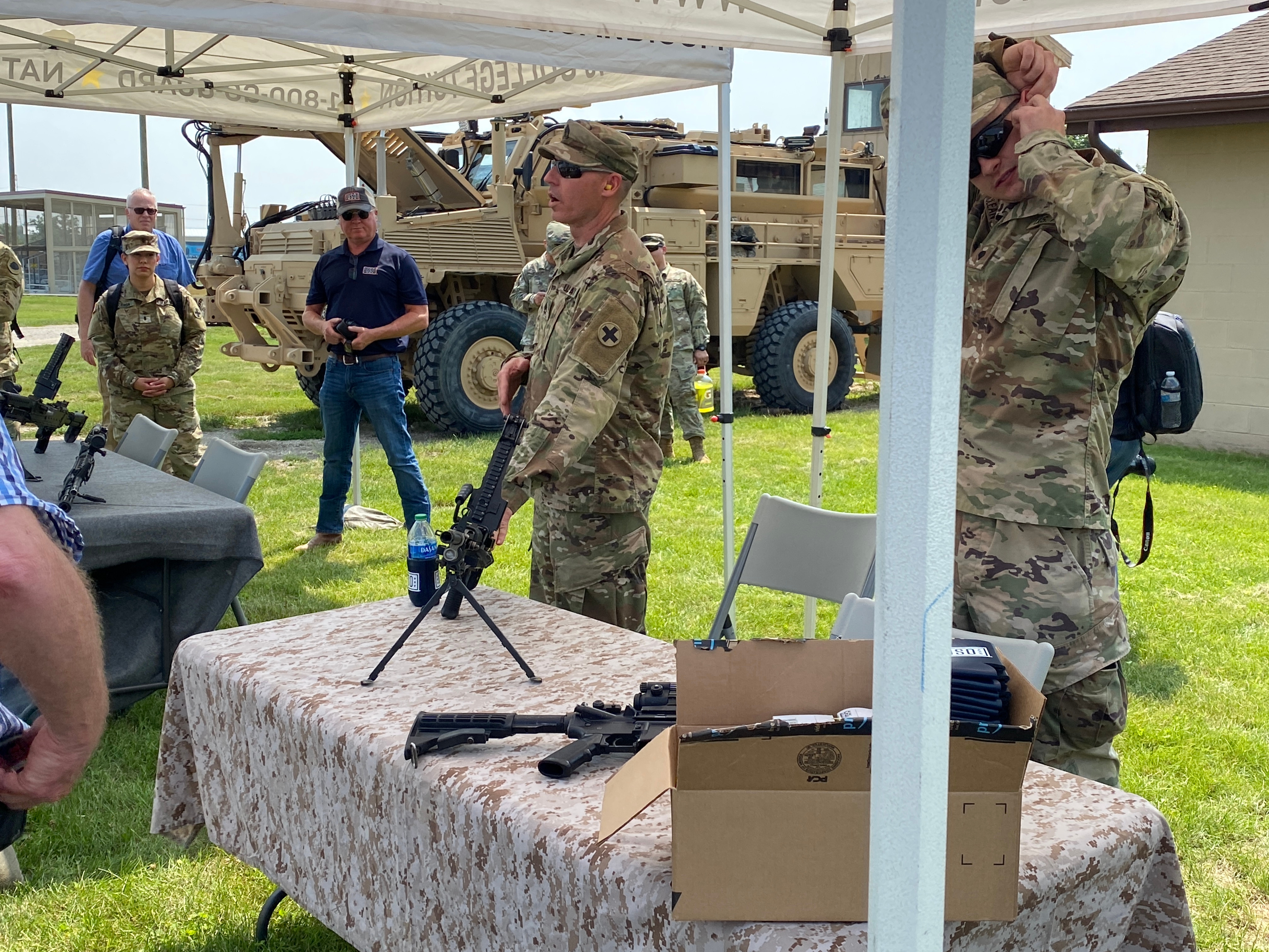Military Base Illinois - The former air traffic control tower at NAS Glenview in 2010 is now listed on the National Register of Historic Places.
42°05′26″N 87°49′21″W / 42.09056°N 87.82250°W / 42.09056; -87.82250 coordinates: 42°05′26″N 87°49′21″W / 42.09056°N 87.82250°W / 42.09056; -87.82250
Military Base Illinois
Naval Station Glview or NAS Glview is a US naval station in operation from 1923 to 1995. Located in Glenview, Illinois, in the Chicago area, the air base primarily operated training aircraft as well as ships on Lake Michigan during World War II. Reorganized as a Naval Reserve base after World War II, NAS Glview supports the Naval Air Reserve, Naval Air Reserve/4th Marine Aircraft Wing, and the US Army Reserve's 244th Aviation Group, as well as a Coast Guard air station.
U.s. Troops In Afghanistan
The base was originally built by Curtiss Flying Service and was intended to be the air service center for Chicago. When the site was dedicated as Curtis Valley on October 20, 1929, it housed the largest hangar built at the time, Hangar One. Hangar One, one of the most advanced hangars at the time, included many innovations that were considered modern at the time. Gigacandela electric lighting was built, which allowed the airport to operate in the dark. A set of carefully designed sliding doors create compartments for storage and space heating. Glass-enclosed galleries allow operators to see the mechanics at work on the first floor. A restaurant and lounge were opened on the highest level. A loudspeaker informs passers-by of their arrival and departure. The final cost of the airport and Hangar One was $3 million in 1930. Adjusted for inflation, the relative value in 2017 would be approximately $44.8 million. It is widely considered to be one of the best airports in the Midwest.
In 1930, the National Air Races were held at Curtis-Reynolds Airport/Curtis Field, and in 1933, the International Air Races were held there in conjunction with the Ctury of Progress. Aviation luminaries such as Charles Lindbergh, Willie Post, Jimmy Doolittle and Art Chester attended.
In 1934, Post attempted to set the altitude record from Curtiss. In 1938, both civilian and military service operated from the site, but in 1940 it was sold to the United States Navy.
Shrinking military budgets between World Wars I and II forced the Army and Navy to focus more on the Reserves and National Guard, with many resources for personnel in these organizations. This is in large areas, given their location. as civilian employment centers. One course the U.S. Navy is taking is to establish a series of Naval Reserve Air Bases (NRABs), the third of which has been established near the Naval Training Station Great Lakes near Chicago. Reservists initially fly and operate seaplanes on the shores of Lake Michigan and at Naval Training Stations in the Little Great Lakes Basin. These facilities became even more inadequate for the new and larger aircraft entering the fleet in the 1930s, and it was recommended that the NRAB be relocated to Curtis-Reynolds Airport/Curtis Field. The proposal was approved and military construction began at Curtis Field on January 4, 1937, followed by a formal designation at the NRAB in Chicago on August 28, 1937.[2][3]
Amazon.com: Naval Station Great Lakes Illinois Patch
For the next three years, the air station's primary role was clearing training for students seeking appointment as Naval Aviation Cadets (NAVCADs). Those students who meet the required standards will later be transferred to NAS Psacola, Florida for further flight training. In 1941, with the entry of the United States into World War II imminent, it became clear to the commander of the Navy in Washington that the initial flight training facilities built at and around NAS Psacola would not be able to expand as needed. Navy. . As a result, naval planners chose to move initial flight training to multiple Naval Reserve air bases around the country and use NAS Psacola for advanced training. NRAB Chicago was selected as the first base in this program as a proof of concept. A further construction schedule of 121 working days covers 1,300,000 square feet (120,000 m).
) New concrete was poured for runways, taxiways and ramps, and new hangars and administrative and support buildings were also constructed and completed in late November 1942. On 1 April 1943, NRAB Chicago was reorganized as NAS Chicago. In 1944 "Chicago" was removed from the air station title and installed at NAS Glview.
Approximately 9,000 aviators from the US Navy, US Marine Corps, and US Coast Guard received their first flight training at NAS Glenview during World War II, accumulating 800,000 flight hours and more than 2 million takeoffs and landings. Later in the war, NAS Glview also hosted advanced training in fleet combat aircraft, primarily for Lake Michigan-based qualification of the Chicago-based training aircraft USS Sable (IX-81) and USS Wolverine (IX-64). Regional Instructor Qualification Training Unit (CQTU).
After the end of World War II, NAS Galview ceased its role as a primary training base and became the headquarters of the newly created Naval Air Reserve Training Command (NAVAIRESTRACOM) in 1946. NAVAIRESTRACOM's primary responsibility was to oversee the various airports in all regions. US, where experienced naval aviators, naval aircrew, and World War II technical personnel could be integrated as naval reserves and retain their full strength should their skills be needed in future conflicts. These skills were readily available to teams and personnel mobilized during the Korean War and the Berlin Crisis.
Deep Underground Military Bases
Each base also has an assigned Naval Air Reserve Training Unit (NARTU), which until the reorganization of the Naval Air Reserve in 1970 "owned" all assigned aircraft. One of the best units based at NAS Glview in the post-WWII period was Attack Squadron 725 (VA-725), part of NARTU Glview until 1970, when it was reorganized as Attack Squadron 209 (VA -209) and became a part. Carrier Air Wing Reserve TWTY (CVWR-20) from 1970 to 1972. Originally flying the A-4B Skyhawk, the pilots later switched to the A-4L Skyhawk. From 1967 to 1972, part of VA-725-cum-VA-209 also served as the Air Barons, a Naval Air Reserve right wing aircraft display group that supplemented the US Navy's Air Force Squadron, Blue Angels, and Display. A US Air Force squadron, the Thunderbirds, has airshow locations in addition to the locations where the Blue Angels or Thunderbirds operate in a given week during the airshow season. VA-209 and the Air Barons were established in 1972.
During the second half of the Cold War from the 1970s to the 1990s, and continuing into the Cold War era after 1995, NAS Glenview was the primary home of two Naval Air Reserve patrol squadrons, Patrol Squadron SIXTY (VP-60). and patrol. Squadron 90 (VP-90). Originally equipped with the P-2 Neptune, both were later replaced by the P-3A Orion, followed by another change to the P-3B Orion Maritime patrol and reconnaissance aircraft. These aircraft are based at NAS Glenview and are staffed by a combination of full-time Operational Training and Reserve (TAR) personnel and part-time Selected Naval Reservists (SELRES). Courses are conducted from NAS Glview, and patrol groups are often deployed overseas for anti-submarine warfare operations against Soviet U-boats and U-boats in the Atlantic and Mediterranean or other operations in the Caribbean.
Another Naval Air Reserve squadron at NAS Glenview is Fleet Logistics Support Squadron FIFTY-ONE (VR-51), operating the C-118 aircraft and later the C-9B Skytrain II, providing operational support aircraft and the transport of military personnel and cargo. in the whole world. VR-51 surveillance work included support of US military operations in Lebanon and Grada in the 1980s and between US and several bases in Southwest Asia during operations DESERT SHIELD / DESERT STORM in the 1990s.
In the mid-1990s, NAS Glview also housed two Naval Air Reserve augmentation/sustainment units, which included two patrol squadron augmentation units with additional P-3 pilots in the active flying position that still regularly fly with VP-60. and VP-90 aircraft, as well as overseeing Naval Air Reserve training programs and related technical/maintenance units at Naval Air Reserve Cter (formerly Naval Air Station) in Twin Cities, Minnesota, the latter facility now part of Minneapolis-St. Joint Air Reserve Station.
Us Amc Battle Staff Conducts Mobility Generation Training At Scott Afb
Prior to its closure due to the 1993 Base Realignmt and Closure Commission decision, the base was also used as a staging area and departure point for aircraft participating in the annual Chicago Air and Water Show. Following the 1993 BRAC decision, VP-60 and VP-90 were also cleared for disbandment and their P-3B aircraft were either assigned to Air Force Reserve groups identified for transfer to NATO and allied forces under Foreign Military Sales (FMS). program, or retired and drunk. VR-51 was also a contract formation with VP-60 and VP-90, with its C-9B aircraft similarly distributed to other VR groups or detached. In November 1997, a new squadron was designated VR-51 as a Naval Reserve squadron at MCAS Kaneohe.
Military base in illinois, illinois military, lejeune military base, military base, military base jobs, camp lejeune military base, military base housing, military base homes, great lakes military base illinois, military base contamination, off base military housing, military base in chicago illinois


0 Comments